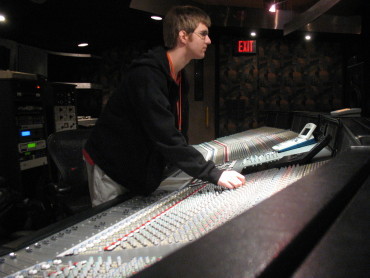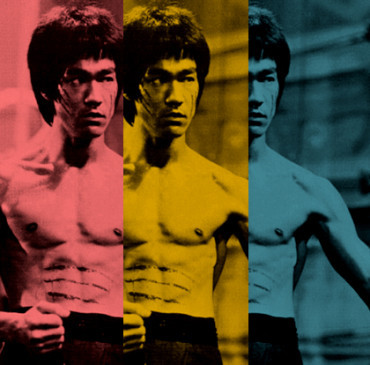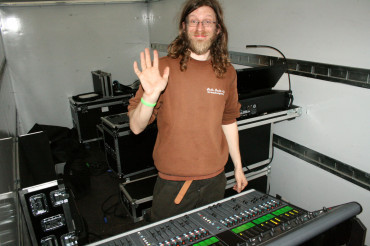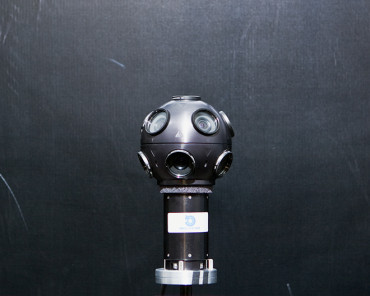Nathan Lively's Blog, page 28
July 7, 2015
Get Booked Solid in Pro Audio
 Here’s how it’s done. The process is simple.
Here’s how it’s done. The process is simple.
Step 1 – Build relationships (aka networking)
“I need to get myself out there.”
People say this all the time, but many of those same people stop short of taking action. Maybe they don’t know who to talk to or what to say. They might not even know how to talk about what they do.
Don’t be like them. Develop a system to regularly and systematically build relationships. Learn how to talk about your work in ways that people will understand.
Step 2 – Get referrals
Turn those relationships into referrals.
Most sound engineers are just waiting for the phone to ring. Don’t do that. By building relationships and asking for referrals you are generating an unlimited supply of opportunities.
Step 3 – Get the gig
If you are doing things to make people hear about you, but they are not hiring you, that’s a problem. New audio professionals on the scene have so much optimism and enthusiasm, but that can quickly turn to panic, fear, frustration, and burnout when they begin to understand the realities of having their own business.
 You have to be able to talk to people about audio if you want them to hire you. Most sound engineers try to explain audio in a way that’s overly technical and has no real compelling meaning to people. That can work every now and then just by attracting people through sheer energy and enthusiasm, but that can actually be a bad thing, because it leads you to think that what you’re doing works. It does technically work, but not consistently or effectively enough for anyone to make a real living this way.
You have to be able to talk to people about audio if you want them to hire you. Most sound engineers try to explain audio in a way that’s overly technical and has no real compelling meaning to people. That can work every now and then just by attracting people through sheer energy and enthusiasm, but that can actually be a bad thing, because it leads you to think that what you’re doing works. It does technically work, but not consistently or effectively enough for anyone to make a real living this way.
You have to be able to talk to clients in the language of results and problem solving. That’s why you’ve got to have a system that will enroll clients consistently and that works almost every time. If you don’t you could be out of business fast (or struggling for years to get this thing off the ground).
Step 4 – Deliver awesome service and be remarkable
If you are great at your job, but people forget about you immediately, you’ll have a hard time moving forward. Even if one client hires you again, they won’t remark about you to other people, which is what you really need to grow your business.
This can be difficult in audio when we are the ones in the control room, backstage, and in the dark at FOH. In fact, having a successful event usually means that nobody knows we are there at all. But there are ways that you can be remarkable and still do a great job.
 What does a remarkable sound engineer look like to you? Is it mixing naked or adding sound effects or making the sound check really fun or lifting weights before the show? What’s unique about you that you can use to add value to your service? Your skills, your sense of humor, your values?
What does a remarkable sound engineer look like to you? Is it mixing naked or adding sound effects or making the sound check really fun or lifting weights before the show? What’s unique about you that you can use to add value to your service? Your skills, your sense of humor, your values?
Focus on being remarkable instead of great. What are your personal super powers? How can you bring surprise, delight, shock, and awe to your work in an authentic way that would make it impossible for people not to talk about you afterward?
Most of my personal examples are subtle. A Portuguese band started hiring me because I was the first engineer to let them do crazy things with microphones. A San Francisco sound designer referred me for great gigs because I was the only one who asked for them. A concert producer hired me because he liked my wireless mix system.
The first one was a coincidence, but the second two were planned. Try to get an outside opinion to help you generate some ideas.
If you’d like to get my opinion on your business and what you can do to be remarkable, sign up for my free 30-minute Get Booked Solid in Pro Audio one-on-one business consultation. There are 1,100 of you and only one of me, so you’ll need to act fast to get a spot.
During this powerful one-on-one coaching session, we’ll work together to:
Identify the key relationships that you need to get the best gigs.
Uncover the communication breakdown that is sabotaging your success.
Create a next-step action plan.
If you’d like to take advantage of this very special, very limited, and totally FREE 30-minute Get Booked Solid in Pro Audio coaching session, sign up now.
Offer expires August 1st!

This article Get Booked Solid in Pro Audio appeared first on Sound Design Live. Sign up for free updates here.
Loved this post? Try these:
Announcing: Pro Audio Business Blueprint
Do You Have A Clear Path To Pro Audio?
Best Tips For Building A Career In Pro Audio

June 23, 2015
How to be Unstoppable
 Nathan has written a couple of things recently about the mindset of being unstoppable.
Nathan has written a couple of things recently about the mindset of being unstoppable.
He asked me to pick up on the topic of motivation and share a few practical tips from my experience producing music, recording bands and doing audio for film, theater and video.
I’ll start with some general things and then we’ll get to something specifically music-related.
IN GENERAL
First of all, and this goes without saying, you gotta be in shape. Stretch, get sweaty, pretend you’re Bruce Lee for 25 minutes per day, keep your mind body and spirit clean clean clean. You will be amazed how easy your “problems” appear to be, after you whip off a set of pushups.
Second, your instrument is an extension of your body. It could be your musical instrument, your studio space, or even your voice on the phone. To be unstoppable you need your healthy exuberance to radiate right through the tools you’re using, to the point where stoppable people say “He makes it look so easy!” and “How did they DO that?”
Third, unstoppably practice extreme visualization of what you want to achieve.
By extreme I mean, see yourself already there achieving it. Fantasize, daydream, mentally drool, go through it a thousand times per day. As often as you can until you can taste it! You’d be surprised how well this works to remove subconscious blockages against success.
Now let’s get serious.
How do you motivate yourself, or a band you’re working with, to finish an album project?
ANSWER: THE UNSTOPPABLE TRACK SHEET
.
.
You can use this as a studio engineer who’s keeping tabs on a session, as a musician, bandleader, or producer. This track sheet makes you unstoppable by giving you a simple way to manage a complicated project.
Remember, visual artists can hang a group of paintings in one gallery and see how they compare to each other. Chefs can see which plate is missing the garnish, and dentists can count the people still sitting in the waiting room.
Musicians can’t do any of those things because music happens only one song at a time. You can’t play a group of songs all at once, it would be chaos!
Because of this linear-sequential character of music, it is dangerously easy to begin one thing, leave it for later, and never return until it’s too late.
So let’s look at the track sheet in detail and see how it can help you avoid common mistakes such as publishing an unmastered song, leaving out a song entirely from an album, or losing a session when it gets deleted from the studio work drive.
I keep these blank track sheets in my google doc’s so I can review them anytime, from any place, especially during down time away from the actual studio work.
Let’s look at the fields:
TRACK SHEET: band name, artist, movie title, event, etc.
Project Name: the album or group of songs
Output: Describe the final delivery format you need to create and deliver. (DVD, songs for a live concert, CD, etc) Include the target date for completion!
These may seem obvious, but it’s important from the very beginning to be thinking of the finished product and deadline.
The heart of the process is in the checklist, so let’s have a look:
WRITING
Track title: or working title
Notes: good place to write the tempo if you’re on grid, and anything else that helps you remember which song it is
Lyrics: Do they exist? Where are they stored so you’ll know where to find them?
Key signature: Is is the right range for the singer? Does the band know what key it’s in? This is especially important for tracking soloists at different times, plus overdubs.
Song form: Do we know the layout (ABABC, verse/chorus)? Where are the solos? How long will this song be? Can the band play it all the way through? Can we print a lead sheet for the band?
Answer all of these questions before you start recording!!!
RECORDING
Basics: The basic tracking. Are all the instruments recorded into one session yet? Are you ready to do the mix session without emergency overdubs?
2mix: A final stereo mix before mastering. Has this song survived the mix session without returning to any of the above stages? Do you know which version is the final mix, and is its file labeled properly?
DELIVERY
Now let’s organize our output formats. Each one of these should be a folder of files on your computer AND backup drive.
HQ master: Has the track been mastered in a full-quality version? What about mastering for radio, for vinyl, for digital?
16/44: Mastering was probably done at least 24-bit depth and 96kHz sample rate. Have you down-sampled the HQ master to CD quality? (16-bit 44.1kHz tracks to send to the CD burning factory)
MP3: Has it been converted to MP3 and tagged with artist, title, etc? Will all the info show up correctly in an mp3 player?
Graphics: are they done? Are you using the album cover as the artwork for every song, or are there individual graphics for each song? These go into the MP3 tagging so people can see pictures in iTunes.
Backups: Think about it now while you still can. With all these versions and edits, have you put them into another place… or are they all sitting on one laptop?
Note: we’ve omitted video from this process, because that is a whole ‘nother ball of wax.
To Summarize — Organizing your work with a
Organizing your work with a track sheet allows you to see the whole project at once, and it leads you through the process of completion so nothing gets left out.
It will help you avoid the #1 pitfall of wasting time. Do not spend three hours making micro-edits on an automation lane while you’re sitting in a miked-up studio with musicians waiting! Likewise, don’t start mastering one song before you know what format they want to publish it in!
And for heaven’s sake don’t let the mix engineer start mastering a song when you already booked a mastering house to do it next month.
Finally, in personal terms, a track sheet helps to keep the momentum moving towards finishing what you’ve started. Nothing is easier than sitting down to noodle around and come up with a million great ideas… but nothing is harder than putting it all together into a finished result, especially when everything is all over the place.
It is all too easy to fall into a slump and feel like “nothing is ever gonna happen with this.”
Track sheets are one more tool in your creative arsenal to help you get out of that slump.
Remember up top, we talked about visualizing success? The track sheet is essentially a visualization tool. The more often you review it, the more powerful it becomes.
Finally, the essence of being unstoppable is simply to succeed in creating something, where others do not.
Good luck!
This article How to be Unstoppable appeared first on Sound Design Live. Sign up for free updates here.
Loved this post? Try these:
FL Studio Rocks + Free Barbie Samples

June 7, 2015
The Graveyard Shift: How Mike Rauchfleisch Built a Thriving Audio Business by Working All-night Parties That No One Else Wanted
In this episode of Sound Design Live, I talk with Mike Rauchfleisch, the owner of Audio Studio Nord in Wilhelmshaven, Germany, about how he built a thriving audio business by working all-night techno parties that no one else wanted. We also discuss:
How to survive long events
How to differentiate yourself as an audio provider
How to offer complete event packages including staging, lighting, and video with strategic partnerships
How to promote your AV company through Facebook
When you start off, you need to get the message across that you are different. We concentrated on stuff [our competitors] didn’t like, so we started off doing techno events.
Show notes:
 All music in this episode by The Tet Holiday
All music in this episode by The Tet HolidayAudio Studio Nord on Facebook and Twitter


This article The Graveyard Shift: How Mike Rauchfleisch Built a Thriving Audio Business by Working All-night Parties That No One Else Wanted appeared first on Sound Design Live. Sign up for free updates here.
Loved this post? Try these:
What a CPA, Bookkeeper, & Business Manager Can Do for Your Business
Announcing: Pro Audio Business Blueprint
How Jim Digby and the Event Safety Alliance Can Save Your Ass

May 13, 2015
360˚ Interactive Live Video Streaming with Zero Crew
Support Sound Design Live on Patreon.
In this episode of the Sound Design Live podcast I talk with Anthony Karydis from Mativision about how they accomplish 360º interactive live video streaming with zero crew. We also disucss their proprietary cameras and multi-channel playback hardware and live mixing concerts.
We are trying to recreate, in your living room, the experience of being in a concert and looking around.
Details from the podcast:
 All music in this episode by Brad Stroud
All music in this episode by Brad StroudSigur Rós live, Chris Milk producing Beck, Muse, Slash, Dream Theatre, Steve Vai
Wirecast, Pro Tools
Terms
CDN: Content Delivery Network
VOD: Video on demand


This article 360˚ Interactive Live Video Streaming with Zero Crew appeared first on Sound Design Live. Sign up for free updates here.
Loved this post? Try these:
From Free To Fee – How To Incorporate Internet Streaming Into Your Live Event
Build A $100,000 Mixing Board
Create Your Own Speaker Processing App + Sound Design Meets Computer Programming

April 16, 2015
Support Sound Design Live on Patreon
Patreon is a great way for people like me to use crowdfunding to support their work. It’s basically like an ongoing Kickstarter campaign where you can pledge a certain amount for each new podcast that I create. Don’t worry about paying to much in a month or accidentally going over your budget because you can set a maximum pledge per month.
My content is still free. I’m just asking for your support. In return, every time you listen to an episode of Sound Design Live you’ll know that you contributed to it’s creation.
 If you want to give a little bit more per month I have a bunch of cool bonus offerings like the Sound Design Live eBook, a monthly Q&A session, career coaching, and even participation during the live interviews.
If you want to give a little bit more per month I have a bunch of cool bonus offerings like the Sound Design Live eBook, a monthly Q&A session, career coaching, and even participation during the live interviews.
Another really cool thing about contributing through Patreon is that the more supporters I have, the more time I can spend on Sound Design Live, and the more great educational interviews I can publish for you. I get lots of great suggestions for people I should get on the show, but I rarely have time to chase them all down. Right now it takes me a whole day to schedule, research, record, edit, mix, publish, and share each episode, so I really only have time for one a month. If enough of you contribute on a regular basis I can change that and start publishing on a more regular schedule.
Basically what I’m saying is that I’d like to move to a system where I publish valuable interviews that you love and you support me for it because it helps you build your career.
Thank you.
This article Support Sound Design Live on Patreon appeared first on Sound Design Live. Sign up for free updates here.
P.S.
Sound Design Live Is Back!
Sound Design From The Actor’s Perspective
Sound Design Live eBook – FREE Chapter

April 15, 2015
Control Ableton Live from your Guitar with Wireless Bluetooth
For the last three years Moldover has been blending his controllerism skills with his life-long love of Guitar. I interviewed Moldover about the evolution of his controller-guitar, The Robocaster, and his collaboration with Livid Instruments to create The Guitar Wing.
And just for fun…
This article Control Ableton Live from your Guitar with Wireless Bluetooth appeared first on Sound Design Live. Sign up for free updates here.
P.S.
Super Fun Instrument Design
Frequency Coordination and Antenna Placement for a Rock-Solid Wireless Microphone System
How To Use Plugins with an Analog Console And Wireless Control

April 13, 2015
How Jim Digby and the Event Safety Alliance Can Save Your Ass
Support Sound Design Live on Patreon.
In this episode of Sound Design Live I talk with the executive director of the Event Safety Alliance, Jim Digby. Digby has worked in the entertainment business for over 30 years as a live event and concert production manager for bands like Linkin Park and Backstreet Boys. We talk about the elements that are necessary to produce safe events, what you should know about labor and safety standards in the U.S., and a few surprises I discovered in the new Event Safety Guide. We also discuss employer-supported hearing conservation and answer these important questions:
Is the rate of event related deaths and injuries going up or down?
Who is the Event Safety Guide for?
Should sound engineers carry professional liability insurance?

The larger our voice, the more effect we have on making sure that everyone who comes to a show goes home from a show, not in a body bag.
Enter The Event Safety Guide Giveaway to win your free copy!
Show notes:
All music in the this episode by Fish & Sheep.
Event Safety Alliance on Twitter, Facebook, and LinkedIn
 The Event Safety Guide
The Event Safety GuideProduction Manager responsibility = All facilities and assets (sound, lighting, buss, trucks, etc.) required to produce a live show.
Tour Manager responsibility = Keep the artist happy.
The Purple Guide
OSHA = Enforcement of safety and health legislation
PLASA = UK-based trade association representing member companies worldwide who work in the entertainment and venue technology fields.
 ADA compliant cable ramp
ADA compliant cable rampThe horrible summer of 2011
Corporate Manslaughter = Knowingly allowing an action to occur that permitted the death of another person.
Quotes
As an unregulated industry, we do really well and produce a lot of safe events.
This is a best-practices book, not a how-to manual.
Our behavior of the past has been cowboy-esque.
The book is a framework for all of us to begin speaking the same language with respect to safety.
It’s not more costly to do it right, it’s more costly to do it wrong.
There’s always someone around the corner that’s willing to do it less expensively and less professionally for you.
This article How Jim Digby and the Event Safety Alliance Can Save Your Ass appeared first on Sound Design Live. Sign up for free updates here.
P.S.
From Free To Fee – How To Incorporate Internet Streaming Into Your Live Event
Save $500 On Your Taxes This Year

March 11, 2015
Build strong client relationships using a CRM
I was surprised to discover that the most popular topic we have discussed in Pro Audio Business Blueprint so far has been how to maintain great relationships with current and past clients. In fact, this is such an important part of running a service-based business that I want you to know about it, too.
Getting booked solid doesn’t happen by accident. It happens because you hustle for it.
In this video I walk you through the initial steps of using a paid app, Contactually, and a free app, Streak, to automate your hustle.
This article Build strong client relationships using a CRM appeared first on Sound Design Live. Sign up for free updates here.
P.S.
Build A $100,000 Mixing Board
The State Of Sound Engineering In Greece

How to build strong client relationships using a CRM
I was surprised to discover that the most popular strategy we have discussed in Pro Audio Business Blueprint so far has been how to maintain great relationships with current and past clients. In fact, this is such an important part of running a service-based business that I want you to know about it, too.
Getting booked solid doesn’t happen by accident. It happens because you hustle for it.
In this video I walk you through the initial steps of using a paid app, Contactually, and a free app, Streak, to automate your hustle.
This article How to build strong client relationships using a CRM appeared first on Sound Design Live. Sign up for free updates here.
P.S.
Build A $100,000 Mixing Board
The State Of Sound Engineering In Greece

February 17, 2015
Decimate Obstacles like Top Touring FOH Engineers
 One of the key lessons I’ve learned on the way to becoming a successful sound engineer is: Be Unstoppable.
One of the key lessons I’ve learned on the way to becoming a successful sound engineer is: Be Unstoppable.
It’s more important than any technical training or piece of gear, and it is one of five lessons we will cover in depth in Pro Audio Business Blueprint (only 19 spots left!).
[originally publish in Behind The Mixer on February 12, 2015]
It’s always a little bit of a letdown to ask a successful sound engineer how they got to where they are today. They usually guess at some combination of passion, hard work, luck, and pixie dust, but nobody ever says they got there by design. It’s easy to look back from a successful point in your career and say, simply, “follow your passion”; it’s a lot harder to give that advice from the most painful and challenging points of your career. That’s why I’m so fascinated with people like Dave Swallow and Ken “Pooch” Van Druten, who were able to push through those obstacles and follow their passion even when things were hard. There is a quality of attitude and a level of skill that they posses, whether they know it or not, that have made them successful.
One of the most important qualities you need to be successful in pro audio is to be unstoppable.
What does that mean, exactly? Should we be rude, pushy, and inappropriate to get what we want? Or should be be committed, but unattached?
Don’t accept no answer for an answer. -George Kao
The secret is to move like a river. When mountains are in your way, learn to flow around them. -Daniel Scott
Building a career in audio is challenging because it’s not a centuries-old trade with a proven career path. It requires daily, creative action to achieve your goals.
Stoppable: I applied for a job. They didn’t call me so I gave up.
UNSTOPPABLE: I applied for a job. They didn’t call me so I applied for another job, connected with two people at the company, sent my resume and show reel to two colleagues for feedback, and made a date with a friend who has had the same job before to ask them how they landed it.
This article Decimate Obstacles like Top Touring FOH Engineers appeared first on Sound Design Live. Sign up for free updates here.
P.S.
Beyond FOH: Job Search Advice For Sound Engineers
Learn from the Sound Engineers for Tori Amos, Prodigy, and The White Stripes Online
How Much Do Live Sound Engineers Make?




